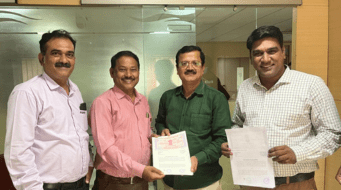-By Arjuna Srinidhi
More than a quarter of the country is turning to desert, including the degradation of agricultural areas (ISRO, 2016). Analyses of satellite images show India has about 32% of its land affected by degradation, of which desertification is a major component.
New areas in the northern state of Jammu and Kashmir and eastern Indian states like Orissa and Jharkhand turning arid, with nine states together accounting for nearly 24 percent of desertification. In states like Jharkhand, Rajasthan, Delhi, Gujarat and Goa, more than 50 percent of land is under desertification

Photo: PTI
What is desertification?
Desertification is the process by which fertile land becomes desert, typically as a result of drought, deforestation, or inappropriate agriculture.
The degradation is a result of loss of vegetation due to deforestation, cutting beyond permissible limits, unsustainable fuel wood and fodder extraction, shifting cultivation, encroachment on forest lands, forest fires and overgrazing. In India, the main culprit is water erosion (26 per cent) followed by degrading vegetation (nearly 9 per cent) and land or soil erosion due to wind.
As much as 105.19 million hectares (Mha) of the country’s total geographical area of 328.73 Mha is being degraded, while 82.18 Mha is undergoing desertification. Rajasthan accounts for the most desertified land (23 Mha), followed by Gujarat, Maharashtra and Jammu and Kashmir (13 Mha each) and Orissa and Andhra Pradesh (5 Mha each). 68 per cent of the country is prone to drought, and this will be further heightened because of the impact of climate change, particularly in dry lands.
“Earlier, soil loss was a slow process which took millions of years. Now, we have managed to change that in just a few decades, but the natural time for the soil to regain what it loses is still as long. So we must take up stalling of degradation on priority”, says CP Rajendran, a senior scientist at the Jawaharlal Nehru Centre for Advanced Scientific Research (JNCASR)
Combatting desertification
India is signatory to the United Nations Convention on Combating Desertification (UNCCD). The country is committed to combat desertification and land degradation and intends to achieve land degradation neutral status by 2030.
India does not have a specific legislative framework or policy for combating desertification, however, the concern for arresting and reversing land degradation and desertification gets reflected in many of our national policies. These include various programmes namely Desert Development Programme; Integrated Wasteland Development; National Watershed Development Project for Rainfed Areas; Soil Conservation in the Catchment of River Valley Projects; National Afforestation Programme; Arid Zone Research; Mahatma Gandhi National Rural Employment Guarantee Scheme; National Rural Drinking Water Programme etc (Press Information Bureau, 2016).
India has managed to reclaim about 1.87mha of land that was under degradation in 2003-05 period, but that has been offset by nearly double the area of productive land (3.63mha) lost to degradation from then to 2011-13 (The Hindu, 2016).
WOTR’s efforts
Since its inception in 1993 WOTR has been in the forefront of mobilizing vulnerable communities in semi-arid and resource fragile regions to help themselves out of poverty by harvesting rainwater wherever it falls and regenerating the ecosystems they live in.
In its 24 years since inception, Watershed Organisation Trust has been involved in over 2098 villages for watershed development, natural resource management and climate change adaptation projects (direct implementation in 637 villages, CB support in 851 villages and MELD support around 610 GP villages), covering over 1.37 million hectares, thus, impacting over 1.8 million people.
WOTR roots itself in Ecosystems Management as a means to reduce risks, mitigate the impact of extreme meteorological events, increase productivity, conserve biodiversity, improve the quality of life and stabilise and enhance nature based livelihoods. It firmly believes that if water is the problem, watershed development is the only solution.
For its work on degraded lands across the country and transforming the lives of communities, WOTR was awarded the 2017 UNCCD award “Land for Life”
Works Cited
ISRO. (2016). Space Applications Centre. Retrieved June 15, 2017, from ISRO: http://www.sac.gov.in/SACSITE/Desertification_Atlas_2016_SAC_ISRO.pdf
Press Information Bureau. (2016). Retrieved June 15, 2017, from PIB: http://www.pib.nic.in/newsite/backgrounders.aspx?relid=73081
The Hindu. (2016). Retrieved June 15, 2017, from http://www.thehindu.com/sci-tech/energy-and-environment/%E2%80%98Almost-30-per-cent-of-our-land-undergoing-degradation%E2%80%99/article14474590.ece





